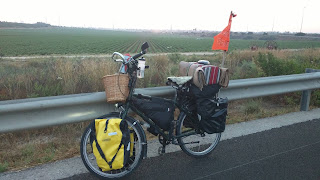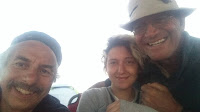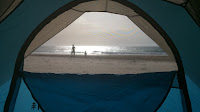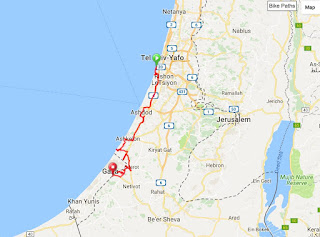Day 1 • 18th May, 2017
Tel Aviv – Zikkim Dunes (Israel)
2.30 am – I slip out of bed and prepare to depart from our urban homestead on the beach. My wife Sunita mumbles something about it being a crazy hour to depart, and goes back to sleep. I am ready in twenty minutes since the bike was loaded the night before. Some coffee in a small thermos and I’m off.
It is still dark but my lights are more than adequate, including the flashing red one above the flag atop the 2-meter (6 feet) pole at the rear of the bike. My front hub dynamo is hooked up to a powerful front beam that illuminates far ahead on the road. Safety first. I am a big believer in strong lights, flags, and very loud air-horns to ward off lazy, sleepy, vicious, or incompetent drivers.
I did no planning for this 2-day trip, vaguely intending to cycle south from Jaffa and hug the coast as much as possible, maybe arriving at the Egyptian border sometime tomorrow evening. We’ll see. My phone is off for at least half of today, so no GPS or paper maps. I am relying on my general knowledge of the area since it’s my home turf. It’s also pretty hard to get lost if you keep the Mediterranean Sea in sight, or at least know where it is.
I begin with a meandering ride from Jaffa through the adjacent towns of Bat Yam and Rishon Letzion. The streets are pretty quiet as I cruise along the Bat Yam waterfront promenade. Several bars, cafes and kiosks are open, and there is a scattering of people both on the streets and in the various establishments.
 Once in Rishon Letzion I continue down to the beach since there is a paved walkway at the edge of the sand. No people except for a lone cyclist. No dogs either which is a relief. I wasn’t sure whether the local strays are nocturnal or not. Apparently they sleep at night, unlike my last trip to Jordan where the dogs would spy me from afar and, yelping all the way, they would careen across the fields towards my bike hoping for a tasty piece of flesh. In Rishon I hear only the twittering of birds. Still dark.
Once in Rishon Letzion I continue down to the beach since there is a paved walkway at the edge of the sand. No people except for a lone cyclist. No dogs either which is a relief. I wasn’t sure whether the local strays are nocturnal or not. Apparently they sleep at night, unlike my last trip to Jordan where the dogs would spy me from afar and, yelping all the way, they would careen across the fields towards my bike hoping for a tasty piece of flesh. In Rishon I hear only the twittering of birds. Still dark.
It was quite a serene ride along the beach, but it ended abruptly at the fencing of an army base. Yes, we have our military on the beach, at the edge of a heavily populated area. And they complain about Hamas embedding their military assets within civilian populations. All armies suck. So I head inland a bit, into Rishon Letzion, trying to find a way back to the beach. I fail. The IDF base is huge. I stumble across their main gate and wave at the sleepy guard whose eyes open wide at the wheeled apparition that appears out of nowhere.
I hit another dead end before circling back to find a way out of town. At this rate I might get to the Egyptian border sometime next week. Finally I find a road leading to route 4, the main north/south highway I’ve been trying to avoid. Oh well there seems to be no choice. It’s a limited access highway and there’s a sign indicating that bicycles and pedestrians are prohibited.
I flag down a passing taxi and ask if there’s an alternate route south. He says not. I point to the no cyclists sign and the taxi driver shrugs in that uniquely Israeli fashion, as if to say, “ Yes well technically it’s prohibited, but no-one really enforces the rule, and anyway who cares”. So I continue onto the highway. It’s still dark yet traffic is increasing, especially the trucks, trying to get ahead of rush hour.
Routs 4 has a decent shoulder, up to 3 meters wide in some spots, so with my lights and flag, I’m reasonable safe. However it’s noisy and dirty, and there’s always a certain tension when a heavily laden truck rumbles past just a meter or two to my left. I look for exits, and finally see a sign for the Ashdod Industrial Zone. Many of the trucks are turning there and so do I. The road leads to the port, but there’s a left turn onto a dilapidated boulevard that looks like it might have once been the main road into the city.
 Dawn is breaking and I take my customary photo of the sun appearing out of the haze.
Dawn is breaking and I take my customary photo of the sun appearing out of the haze.
I pause for breakfast and a bathroom break at a gas station, meticulously locking the bike with two locks, covering it with a nylon cover, and taking with me the pannier bag containing my laptop and other valuables. One can never be too persnickety about personal security on the road, especially in a country like Israel where stealing bicycles seems to have become a national sport.
Back on the boulevard, there’s now a rundown brick sidewalk so I cycle there instead of the road, passing block after block of dreary-looking 1950s and 60s industrial-looking apartment buildings, remnants of the era of mass immigration from other Middle Eastern countries.
Finally these give way to a redeveloped neighbourhood of newer buildings, parks, and even a new cycling path for a while. I pass other cyclists and pedestrians on their way to work. No-one is smiling. Some scowl at me. Who knows why. I wish everyone a good morning and get no response except from one fellow on an electric folder. Tired of this, I start to look for a way out of Ashdod, thinking that I need to head south a bit faster, rather than fulfil my original mission of hugging the coast.
I find a way back to route 4 and continue south, passing Nitzan, which hosts a museum commemorating Gaza settlements which were evacuated. Many former residents of the Gush Katif settlement bloc in Gaza moved to Nitzan after their evacuation by former Prime Minister Ariel Sharon. Their trauma over the destruction of their lifes’ work is now being inherited by the next generation.
This gets me thinking about the string of Palestinian Arab villages that used to dot the countryside along the route I was travelling. In 1948 a huge number of people were herded south across the Egyptian lines to become refugees. Villages such as Al-Nabi Rubin, Yibna, Isdud, Hamama, and dozens more – no longer exist. Perhaps like Combatants for Peace which brings fighters from both sides together, one day the Jewish refugees from Gaza might make common cause with the Arab refugees from former Palestinian villages. Yes, yes. I know. But I can still dream. If we lose the ability to dream what now seems impossible, then we lose a part of what makes us human.
I continue cycling, lost in thought. Lost in my dreams. Damn them all. Israelis and Palestinians. Where are the dreamers? Where are the leaders of vision that we can all follow, Jew and Arab alike. Instead we have returned to combining the ugliness of narrow nationalism with archaic and oppressive religious practice. The leaders in power today only espouse ideologies that are dragging us all into the pits of disaster. May the Gods help us.
OK. Enough ranting. Ashkelon approaches. This is another Israeli port city, an important one. A huge amount of the country’s imports enter here. It’s also a favourite port for cruise ships – the closest port to Jerusalem.
I pull into a shopping mall. My bum is starting to feel the unaccustomed activity. It’s been a while since I did any long distance cycling. My phone has been turned off but it feels like about 10am. Not. It’s only 8.45. Not bad. With my zig zagging through various towns, I’ve covered about 50 kilometers (about 30 miles) since 3am. Time for a nice break. I find an ‘Aroma Cafe’, the Israeli version of Starbucks, and settle in for a mint tea and a writing session. I also charge my phone and laptop. It seems so weird not to automatically check my email, WhatsApp, and FaceBook – which I usually do at least once an hour during my 14 or 16-hour work day. I am determined to get past noon before checking my digital life. It’s a busy period with work, but my phone is forwarded to Sunita who is more than capable of taking care of any work-related crisis or emergency. Anything else can wait until I emerge from my digital silence.
I’ve been sitting for 90 minutes. Time to get back on the road. I tire of route 4 pretty quick. Luckily there’s an exit for Ashkelon in a few kilometers so I take the turn and immediately spy as sign with an arrow that looks good “to the Beach”. The exit off the highway quickly becomes a broad modern boulevard with a nice bike lane along one side. However it’s a bit of a distance to the sea and my energy is starting to flag. I’ve been more than 6 hours on the road. Finally I see the sea, and the boulevard turns downhill with playful fountains in the center strip. My anticipation was thwarted though, because the road dead ended at a private beach that I believe required is restricted to local residents. However the nice guard gave me some directions through the city, and informed me that it was not necessary to go back to the highway in order to arrive at Kibbutz Zikkim. On my way off the beach area I notice a sign instructing people what to do in the event of a tsunami. That’s a new thought for me. I guess the occasional earthquake in the Mediterranean can trigger a giant wave. Watch out!!
So I bike back up the hill and take a right at the second roundabout as instructed. The road ended at a national park that required 28 shekels to enter. I pass. Then I go back and take the third roundabout and meander through Ashkelon in the general direction of south. I’m getting hungry but decide to press on. None of the local restaurants look like a good place for a vegan. I pause at a little park where a dozen elderly gentlemen were playing several games of cards. Three of them give three different answers to my request for directions.
It’s after 12 so I turn on the phone and the GPS shows me the way – only 6.4 kilometers. Yipee. I press on and find myself on a neglected back road leading out of the city that looks like it may have been the original north/south highway a few decade ago. The landscape is an odd mix of sand dunes, industrial estates and what I thought was an army base turns out to be the outer security fence of the Ashkelon power station which supplies a good chunk of the electricity to this part of the country. I believe it still burns coal.
Then over a final rise I see the water again. The kibbutz is on my left, but the sea beckons ahead. What to do. I decide to follow the signs to ‘Zikkim Dunes’ and it proved the correct choice. No kibbutz for me tonight. The beach is relatively pristine, albeit within the power station just a kilometer to the north, and the Gaza Wall about 500 meters to the south. Since it’s mid-week, there’s just a couple of dozen people scattered around. Unfortunately a small group of young men are playing Mizrachi pop on an enormous speaker, so I head over to the bamboo kiosk-cafe and order a lunch of hummus, small salad, and chips, which together with a large bottle of water, cost 75 shekels. A minor ripoff but the food takes the edge off my hunger. It’s now 1pm. I’ve been on the roads for 10 hours and with all the exploration of the various towns and cities, I guestimate my biking distance at about 80 kilometers.
The wind is high and the fine sand gets into everything. I decide not to use the laptop since the sand will no doubt find its way into the innards of the machine.
 I meet Avi. He makes a beeline for my bike and was in awe of the machine and me. He and his daughter are camping on the beach and I am invited to join them. Good plan. Aviv seems like a stand up guy, and some of the young men around look like ne’er-do-wells. Safety in numbers. We carry my panniers over to their camp site, then carry the bike. Bicycles don’t do well in sand. After I put up the tent, I am offered refreshment, and we chat about family, politics and the state of the world. Then we stroll together down the beach to the barbed wire border and get yelled at by soldiers for getting too close.
I meet Avi. He makes a beeline for my bike and was in awe of the machine and me. He and his daughter are camping on the beach and I am invited to join them. Good plan. Aviv seems like a stand up guy, and some of the young men around look like ne’er-do-wells. Safety in numbers. We carry my panniers over to their camp site, then carry the bike. Bicycles don’t do well in sand. After I put up the tent, I am offered refreshment, and we chat about family, politics and the state of the world. Then we stroll together down the beach to the barbed wire border and get yelled at by soldiers for getting too close.
 After impressing my new friends by cooking a fine dinner over my woodburning camp stove, I crawl into the tent at about 9pm for a well earned sleep – or so I thought. The group of young men near the tent swells in number and the music gets louder, and louder. Someone brings a generator and an even bigger sound system is hooked up. The beer flows. The music and voices get even louder. It’s a party. Not much sleep on this night.
After impressing my new friends by cooking a fine dinner over my woodburning camp stove, I crawl into the tent at about 9pm for a well earned sleep – or so I thought. The group of young men near the tent swells in number and the music gets louder, and louder. Someone brings a generator and an even bigger sound system is hooked up. The beer flows. The music and voices get even louder. It’s a party. Not much sleep on this night.


Comment (0)